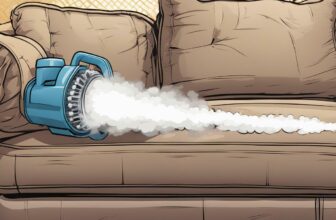
Oil stains are never welcome on any material, especially paper. Whether it’s from cooking oil, grease, or even makeup, these unsightly marks can ruin the appearance of paper documents or art projects. Fortunately, there are several DIY oil stain removal techniques that can effectively remove even the most stubborn stains. In this section, I will provide a step-by-step guide on how to remove oil stains from paper, along with tips on preventing future stains.
Key Takeaways:
- Oil stains on paper can be removed using DIY techniques.
- Prevention is key to avoiding future oil stains on paper.
- Proper drying and restoration techniques are necessary after removing oil stains.
Understanding Oil Stains on Paper
Removing oil stains from paper can be tricky, and it’s important to understand how these stains can affect the paper before trying to remove them. Oil stains can cause the paper to become translucent, discolored, or even deteriorate over time. Therefore, it’s crucial to remove oil stains as soon as possible to prevent further damage.
There are several effective methods to remove oil stains from paper. However, the success of each method depends on factors such as the type of paper, the age of the stain, and the type of oil that caused the stain. In this section, I will provide you with some useful tips and techniques to help remove oil stains from paper effectively.
Types of Paper and Stains
When it comes to removing oil stains from paper, it’s essential to understand the type of paper and the type of oil stain. Different paper types may require different techniques, and some oil stains may be more stubborn than others.
For example, glossy paper is less absorbent than matte paper, making oil stains more difficult to remove. Additionally, vegetable-based oils, like olive oil, leave behind a greasy residue that can be tough to tackle. In contrast, mineral-based oils, like motor oil, can penetrate the paper and leave a permanent stain if not removed promptly.
Effective Methods to Remove Oil Stains
One of the most important things to remember when removing oil stains from paper is to act fast. The longer the stain sets, the harder it will be to remove. Here are some useful tips to help you remove oil stains from paper:
- Use a dry cloth or paper towel to blot the excess oil carefully. Be gentle and avoid rubbing the stain, as this can spread the oil further.
- Apply baking soda or cornstarch to the oil stain, and let it sit for at least 30 minutes. These products will absorb the oil, making it easier to remove.
- Use a soft-bristled brush or eraser to remove the oil stain gently. Be careful not to damage the paper while doing so.
- Apply a small amount of rubbing alcohol to the oil stain. The alcohol will break down the oil and help remove it from the paper.
- If the oil stain persists, try using a specialized oil stain remover. These products are designed specifically for removing oil stains from paper and can be purchased at most craft or office supply stores.
Oil Stain Removal Tips
Here are some additional tips to help you remove oil stains from paper:
- Always test any oil stain removal method on a small, inconspicuous area of the paper before applying it to the entire stain.
- Be gentle when removing the oil stain to avoid damaging the paper further.
- Stay away from heat sources, such as irons or hair dryers, when removing oil stains from paper, as they can cause the stain to set further.
By understanding the type of paper, type of oil stain, and using effective oil stain removal techniques, you can successfully remove oil stains from paper. With patience and a little know-how, you can restore your paper to its former glory in no time!
Absorbing Fresh Oil Stains
If you have just noticed an oil stain on your paper, don’t panic! Quickly absorbing the oil can prevent permanent damage. Here are some easy oil stain removal techniques that you can try:
| Natural Remedies | Common Household Items |
|---|---|
| Baking soda: Sprinkle baking soda on the oil stain, let it sit for a few minutes and then gently brush it off. | Cornstarch: Sprinkle cornstarch on the oil stain and leave it for a few hours before brushing it off. |
| Talcum powder: Apply talcum powder on fresh oil stains and leave it for several hours before brushing it off. | White bread: Gently press a piece of white bread on the oil stain to absorb the oil, then carefully peel it off. |
| Chalk: Rub chalk onto the oil stain and let it sit for a few minutes before brushing it off. | Paper towel: Place a paper towel on the oil stain and press down gently to absorb the oil. Repeat until the stain is gone. |
Remember to be gentle when applying any of these natural remedies or household items to your paper. Rough handling can cause more damage to your paper than the oil stain.
Precautions:
If the oil stain is on a valuable piece of paper, it is advisable to avoid using any of these methods and seek professional help instead. Also, do not use water to remove oil stains as it can make the stain worse.
Removing Set-In Oil Stains
Set-in oil stains can be tough to remove, but there are several effective methods you can try. Here are some of the best ways to remove oil stains from paper:
| Method | Description |
|---|---|
| Dish soap and warm water | Mix a few drops of dish soap with warm water and use a sponge to gently scrub the stain. Rinse with clean water and pat dry with a towel. |
| Rubbing alcohol | Apply a small amount of rubbing alcohol to a clean cloth and gently rub the stain until it disappears. Rinse the area with water and pat dry. |
| Baking soda paste | Mix baking soda with a small amount of water to create a paste. Apply the paste to the stain and let it sit for several hours before gently wiping it away with a damp cloth. |
| Cornstarch | Sprinkle cornstarch over the stain and let it sit for several hours. Use a soft-bristled brush to gently remove the cornstarch, then wipe away any remaining residue with a damp cloth. |
It’s important to note that set-in oil stains may require multiple attempts at stain removal. Be patient and persistent, and avoid using harsh chemicals or abrasive materials that could damage the paper.
In addition to these methods, there are several oil stain removal techniques worth considering, such as pre-treating the stain with a stain remover or using solvents like acetone or mineral spirits. Remember to always test these methods on a small, inconspicuous area of the paper before applying them to the stain.
With these best ways to remove oil stains, you can restore your paper to its original condition and ensure its longevity.
Pre-Treating Oil Stains on Paper
Pre-treating oil stains on paper can increase the chances of successful removal. Here are some effective pre-treatment methods to try:
- Blotting: If the oil stain is still fresh, blot the area with a clean, dry paper towel to remove as much excess oil as possible.
- Cornstarch: Sprinkle cornstarch over the oil stain and let it sit for about 15 minutes. The cornstarch will absorb the oil, and you can then brush it off gently with a clean, dry brush.
- Dry cleaning solvent: If the oil stain is on a valuable or delicate document, you may want to use a dry cleaning solvent such as K2r or Afta. Apply the solvent to a cotton swab or cloth and blot the stain gently. Be sure to test the solvent on an inconspicuous area of the paper first.
- White vinegar: Mix equal parts white vinegar and water and apply the solution to the oil stain with a clean cloth. Let it sit for a few minutes, then blot the area with a dry cloth.
Remember to always test your pre-treatment method on an inconspicuous area of the paper before applying it to the stain. This will help you avoid any additional damage to the paper.
Testing Stain Removal Methods:
Before you start applying any DIY oil stain removal techniques, it is essential to test them on a small, inconspicuous area of the paper. Doing so will help you avoid any unwanted damage to the paper and ensure that the method you choose is effective.
To perform the test, apply a small amount of the cleaning solution to the corner of the paper and let it sit for a few minutes. Use a clean, white cloth to blot the area gently. If the paper shows any signs of discoloration or weakening, discontinue the use of that method. If there is no visible damage, you can proceed with the cleaning process.
When choosing a cleaning solution, make sure to select one that is safe for the type of paper you’re dealing with. For example, acidic solutions should not be used on delicate papers, as they can cause further damage.
It’s also important to note that not all oil stain removal methods work on all types of paper. For example, some methods may work great on glossy paper but not on matte paper. Keep this in mind and adjust your approach based on the type of paper you’re working with.
In conclusion, a simple test can save you time and money when it comes to removing oil stains from paper. Take the time to perform a small test before proceeding with any cleaning method, and you’ll be one step closer to achieving a successful outcome.
Using Solvents for Oil Stain Removal
When it comes to removing stubborn oil stains from paper, solvents may be necessary. However, caution must be taken as some solvents may damage the paper. Here are some effective oil stain removal techniques using solvents:
1. Mineral Spirits
Mineral spirits can effectively break down oil stains without damaging the paper. Apply a small amount of mineral spirits onto a clean cloth and dab the stained area gently. Repeat if necessary. It is important to test on a small, inconspicuous area of the paper before proceeding with this method.
2. Rubbing Alcohol
Rubbing alcohol can also be used to remove oil stains from paper. Dab a small amount of rubbing alcohol on a clean cloth and gently blot the stained area. Repeat the process as necessary.
3. Acetone
Acetone should be used as a last resort as it can cause damage to some types of paper. Apply a small amount of acetone onto a clean cloth and gently dab the stained area. Rinse with water immediately after removing the stain.
When using solvents for oil stain removal, it is important to work in a well-ventilated area and wear protective gloves. It is also important to avoid using solvents on delicate or antique paper.
If you are unsure about using solvents for oil stain removal, seeking professional help may be the best solution.
Drying and Restoring Paper
After successfully removing the oil stain, it’s important to dry and restore the paper properly to ensure its longevity. Here are some DIY and natural methods for drying and restoring paper:
| Method | Description |
|---|---|
| Air-drying | Gently place the paper on a clean surface and let it air-dry naturally. Avoid direct sunlight and heat sources as they can cause the paper to warp or yellow. |
| Baking soda | Place the paper in a container with a lid and cover it with a layer of baking soda. Seal the lid and leave it for 24 hours. The baking soda will absorb any remaining moisture and odor. |
| Cornstarch | Place the paper on a flat surface and sprinkle cornstarch over the affected area. Let it sit for a few hours and then gently brush off the excess cornstarch. |
It’s important to note that restoring paper can be a delicate process and it’s recommended to seek professional help if you are unsure about the best method.
Professional Help for Stubborn Stains
If you’ve tried all the DIY methods and the oil stain on your paper is still there, it may be time to consider seeking professional help.
Professional stain removal services have access to specialized equipment and chemicals that may be more effective in removing stubborn oil stains. They also have experienced technicians who can assess the situation and determine the best course of action.
When looking for a professional stain removal service, do your research and choose a reputable company with positive reviews. Ask about their techniques and equipment, as well as their experience in removing oil stains from paper.
While professional help may come at a cost, it may be worth it to salvage your valuable documents or artwork. Plus, it can save you the time and effort of trying multiple DIY methods that don’t work.
Remember, prevention is key to avoiding future oil stains on paper. However, if oil stains do happen, don’t panic and try these effective methods to remove oil stains. And if all else fails, don’t hesitate to seek professional help.
Preventing Future Oil Stains
Prevention is the key to keeping your paper oil-free and clean. Here are some easy oil stain removal tips to help you avoid future stains:
- Handle paper with clean hands to avoid transferring oils to the paper.
- Avoid placing paper on surfaces that may have oil or grease residue.
- Store paper in a dry, clean environment away from oils or greasy substances.
- If you use oils or lubricants in your workspace, cover your paper to protect it from splatters.
- Avoid using oily or greasy substances near paper items.
- Regularly clean your workspace and surfaces to avoid buildup of oils and grease.
By following these simple oil stain removal tips, you can help keep your paper clean and avoid the need for future DIY oil stain removal or professional help.
Conclusion
In conclusion, knowing how to remove oil stains from paper is an essential skill that can save your important documents and keep them looking pristine. From understanding how oil stains affect paper to using DIY techniques, natural remedies, and solvents, there are several effective methods for removing oil stains.
Final Thoughts on Oil Stain Removal Techniques
While some oil stains may be stubborn and require professional help, most can be removed using the methods discussed in this article. It is crucial to perform a small test before applying any stain removal method and to take care when using solvents.
The Importance of Prevention
Prevention is always better than cure, and avoiding oil stains on paper is no exception. Simple tips such as handling papers with clean hands, storing them properly, and avoiding contact with oily substances can go a long way in preventing oil stains.
With these oil stain removal techniques and prevention tips, you can maintain the quality of your important papers and documents. Remember to handle them with care and seek professional help if DIY methods fail.
FAQ
Q: Are these DIY oil stain removal techniques safe for all types of paper?
A: These techniques are generally safe for most types of paper, but it’s always a good idea to test them on a small, inconspicuous area first to ensure no damage occurs.
Q: What household items can I use to absorb fresh oil stains?
A: Common household items such as baking soda, cornstarch, or talcum powder can be used to absorb fresh oil stains on paper.
Q: How do I pre-treat an oil stain on paper?
A: To pre-treat an oil stain on paper, gently dab the stained area with a clean cloth or paper towel to remove any excess oil, and then apply a small amount of dish soap or laundry detergent to the stain.
Q: Can I use solvents to remove oil stains from paper?
A: Yes, solvents can be effective in removing oil stains from paper. However, it’s important to use them with caution and follow the instructions carefully to avoid damaging the paper.
Q: How should I dry and restore paper after removing an oil stain?
A: After removing an oil stain, gently blot the area with a clean cloth or paper towel to remove any excess moisture. Then, allow the paper to air dry completely before storing or using it.
Q: When should I seek professional help for stubborn oil stains?
A: If DIY methods fail to remove stubborn oil stains from paper, it may be best to seek professional help. They have specialized tools and techniques that can effectively remove even the toughest stains.
Q: How can I prevent future oil stains on paper?
A: To prevent future oil stains, it’s important to handle paper with clean hands, avoid eating or drinking near paper, and store it in a dry and clean environment.





